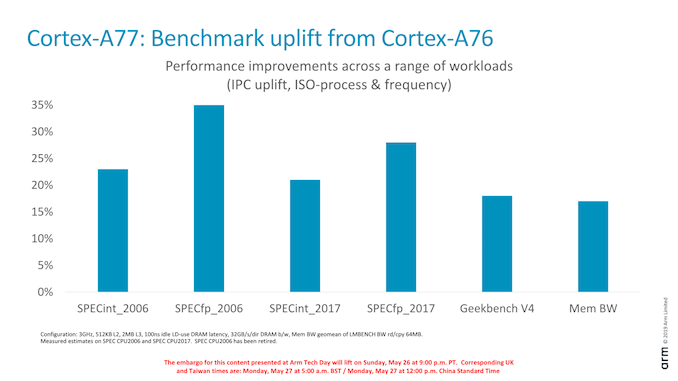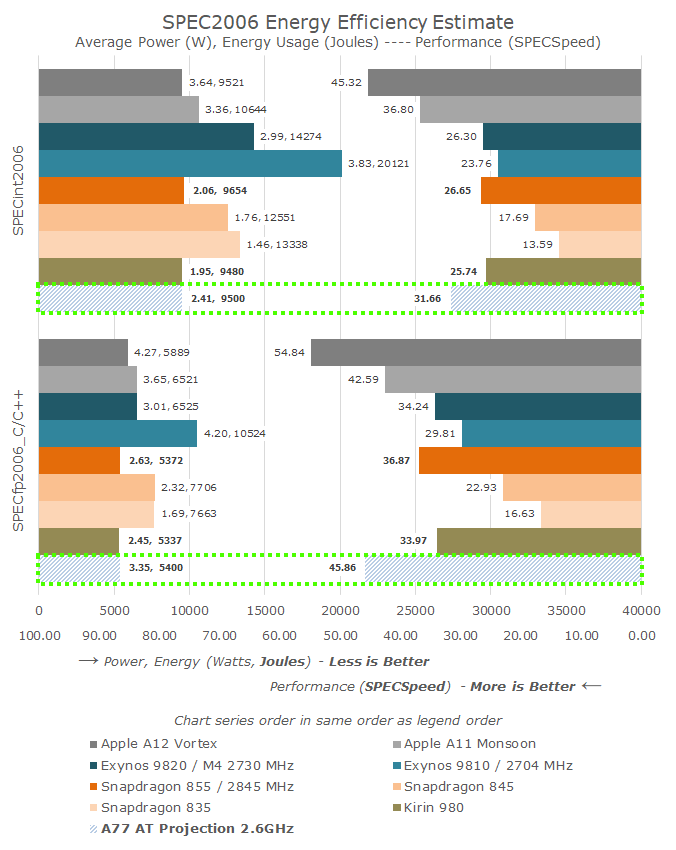Arm's New Cortex-A77 CPU Micro-architecture: Evolving Performance
by Andrei Frumusanu on May 27, 2019 12:01 AM ESTPerformance Targets: 20-35% Better IPC
The Cortex-A77 saw some interesting microarchitectural changes that promise to increase performance. The question now remains where exactly the targeted performance gains will end up at?
In terms of published performance improvements, Arm opted to stay with SPEC2006, 2017, GeekBench4 and LMBench memory bandwidth. Our focus here will be on SPEC2006 as it’s still the most relevant benchmark among the set for mobile.
On SPECint2006, the A77 promises around a 23% IPC increase, while SPECfp2006 claims a more staggering 35% boost. The 23% increase for integer workloads was more or less in line with what we expected of the CPU core, however the 30-35% increase for FP workloads I must admit came as quite a surprise, particularly since we haven’t seen any significant changes on the FP execution units of the core. An explanation here would be that SPEC’s FP test suite is more memory intensive than the integer suite, and the Cortex-A77’s various microarchitectural improvements would be more visible in these workloads.
Last year I had made performance and efficiency projections for the A76 at two frequency points, and I ended up being quite close to where the Kirin 980 and Snapdragon 855 ended up landing. For the Cortex-A77, things should be a lot more straightforward to project as we won’t see major process node changes in the next generation 7nm SoCs.
Baselining on the current results of the Kirin 980, I simply extrapolated performance based on the published IPC increases for a theoretical 2.6GHz Cortex-A77 SoC. It’s to be noted that although Arm this year again talks about 3GHz target frequencies for the A77, I’m not expecting vendors to quite reach this frequency in upcoming SoCs, thus the 2.6GHz projection.
In terms of performance, the integer suite would see some solid improvement, however the floating-point results are a lot more interesting. If correct, the A77 would exceed the FP performance of Apple’s A11 and make for quite a big generational push even though we’re not expecting big process node improvements. It’s to be noted though that the A77 will have to compete with Apple’s A13 later this year as well as next-gen M5 cores from Samsung.
Arm promises energy efficiency of the A77 will remain the same as current-gen A76 SoCs. Thus at peak performance, both CPU cores would use the same amount of energy to complete a set workload. The increased performance of the A77 would however have one drawback: Increased power usage, linear with the increased performance figures. This latter increased power usage would seemingly reach levels where running more than two cores at peak frequency would be more problematic in a mobile SoC. Luckily, most vendors have moved on from 4 full-speed big cores to 2+2 or 3+1 designs where there’s only one or two high-power big cores.
It’s to be noted although we’re talking about big cores here, the A77 is said to be only 17% bigger than the A76 – still significantly smaller than the next best microarchitecture from the competition.
End Remarks
Overall the Cortex-A77 announcement today isn’t quite as big of a change as what we saw last year with the A76, nor is it as big a change as today’s new announcement of Arm’s new Valhall GPU architecture and G77 GPU IP.
However what Arm managed to achieve with the A77 is a continued execution of their roadmap, which is extremely important in the competitive landscape. The A76 delivered on all of Arm’s promises and ended up being an extremely performant core, all while remaining astonishingly efficient as well as having a clear density lead over the competition. In this regard, Arm’s major clients are still heavily focusing on having the best PPA in their products, and Arm delivers in this regard.
The one big surprise about the A77 is that its floating point performance boost of 30-35% is quite a lot higher than I had expected of the core, and in the mobile space, web-browsing is the killer-app that happens to be floating point heavy, so I’m looking forward how future SoCs with the A77 will be able to perform.
But even in the integer workloads a 20-25% IPC gain is absolutely marvellous improvement, and we do trust Arm to be able to maintain energy efficiency of the A76. Power will go up slightly, but I think the industry has shown that mobile devices today handle at least two higher power cores properly, so future SoCs should continue with big+middle+little CPU configurations.
Coming A77 SoCs from vendors are expected to still be 7nm – Qualcomm and HiSilicon are the two obvious leading customers that would adopt the core and I’m expecting similar timeframes as last generation’s chipsets. For now- Arm’s delivering on their promised 20-25% yearly CAGR and we believe this to continue for the foreseeable next few generations.












108 Comments
View All Comments
Lodix - Monday, May 27, 2019 - link
Andrei, are you still expecting HiSilicon to launch a Kirin SOC using ARM IP later this year with all that is happening ? It is very sad the current situation.Andrei Frumusanu - Monday, May 27, 2019 - link
The SoC certainly is ready to go to manufacturing. What happens with devices is another question.Violet Giraffe - Tuesday, May 28, 2019 - link
You find it said that a certain company finally has to pay for its practice of stealing and selling IP they do not own? I don't.a94 - Wednesday, May 29, 2019 - link
You know that Huawei always pay the royalty for licensing ARM IP to make their Kirin right? If not, how did they announce that a version of Kirin was based on Cortex something without ARM suing them? Maybe, Huawei did steal some IP from another company, but to be banned of access to a product they always pay(ARM) is ridiculouscolinisation - Monday, May 27, 2019 - link
Hi Andrei,Can you comment at all on the possibility of an A55 refresh? I realise A55 recently replaced A53, but I wonder where ARM go from here. It seemed with the Neoverse E1/A65 out there, we would see a relatively quick replacement. In your opinion is this on the cards or does the move to out of order execution mean too high a power penalty currently with that design.
Thanks
Santoval - Monday, May 27, 2019 - link
On average a new "small" ARM core is launched with every third "big" ARM core. A55 was not launched very recently, it launched along with the A75 core in 2017. Since the A77 cores are also intended to be paired with the A55 cores, the successor of A55 should be launched along with the A78 core -assuming it is called that way- which currently has the codename Hercules.Andrei Frumusanu - Tuesday, May 28, 2019 - link
The A65 won't be seen in mobile because SMT doesn't make sense in mobile, it's not energy efficient.We should expect a new small core along with the next major refresh from the Sophia team after A78/Hercules in 2 years.
name99 - Tuesday, May 28, 2019 - link
The slow cadence for small cores is REALLY delaying the pickup of ARM extensions. How long till ARM proper is shipping PAE and the SPECTRE-instructions in 8.5?They’ve got to see that this is no longer a sensible strategy!
peevee - Tuesday, May 28, 2019 - link
Given that even A76 has about the same perf/W as A55, do A55s even make any sense now?And SMT is a much cheaper way to take advantage of large back-end than a very complex OoO we have now.
Meteor2 - Monday, June 3, 2019 - link
Maybe at the top-end, but does A76 match A55 at lower power levels? Which is what A55 is optimised for?